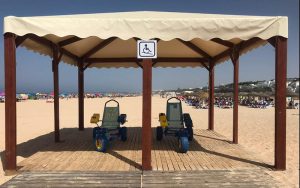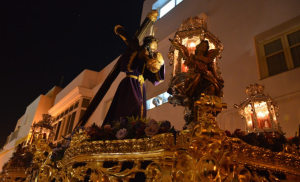The beach of Caños de Meca .
The beach of Los Caños de Meca is a Natural Monument located in the domain of the Cape Trafalgar Lighthouse. Its beautiful landscape mixes fine sand dunes, extensive beaches and a rocky area on which the lighthouse sits.
The cabo de Trafalgar is a cape Spanish belonging to the municipality of Barbate, located on the Atlantic coast of the province of Cadiz, in Andalusia.
The Trafalgar Tombolo ( 36°11′0″N 6°2′0″O) includes the Cabo de Trafalgar and the small isthmus that joins it with the mainland, all located in the municipality of Barbate, in the province of Cadiz (Spain) and which is protected as natural monument by the Junta de Andalucía in an extension of 241.876 m2, mainly for its geological value.
36°11′0″N 6°2′0″O) includes the Cabo de Trafalgar and the small isthmus that joins it with the mainland, all located in the municipality of Barbate, in the province of Cadiz (Spain) and which is protected as natural monument by the Junta de Andalucía in an extension of 241.876 m2, mainly for its geological value.
From the population center of Los Caños de Meca to the cliffs appear the famous Caños that give name to the area. These are freshwater springs on the cliff wall with different flows, from small dampnesses on the rocky wall to important springs, which vary greatly depending on the season and the rainy season. The most important, the Caño grande is located almost at the end of the cliff area, with a very complicated access and only at low tide.
How the beach was formed in this place.
The sand dragged by the tides created a double tombolo or tongue that joined the islet with the coast, enclosing a depression flooded by the rain. When the sea retreated, the wind originated dune systems on the beaches south of the islet, contributing to its fossilization. On the old coast, the east developed another dune system, today covered with junipers and mastic trees.
It is a small islet located between the coves of Conil and Barbate linked to the mainland by a double tombolo of sand, which is considered the northwestern end of the Strait of Gibraltar.
It is part of the Network of Protected Natural Spaces of Andalusia (RENPA), with the category of natural monument and under the name of Tómbolo de Trafalgar.
History:
At the beginning of civilization, maritime transport was essential for the development of large cities, Caños de Meca, as well as Barbate, Bolonia or Tarifa have been cities where the legacy of civilizations is a fact. Cape Trafalgar, besides being witness to one of the main maritime battles of all times (1805), was once an obligatory stop on the routes maritime routes to Gades (Cadiz), Hispalis (Seville) and Onuba (Huelva) among others.
As in Bolonia, in Los Caños the tuna was cared for and prepared, especially for the extraction of garum.
But the most characteristic of the place are:
Its archaeological sites, such as the Roman temple of the god Juno with sacrificial altar submerged in the waters of Cape Trafalgar, there is no evidence of this and a salted fish factory.
From the Hispano-Muslim settlement is preserved part of a watchtower of the ninth century, dismantled in the nineteenth century to build the current lighthouse.
However, the event that makes it famous is the Battle of Trafalgar, which took place in 1805, in which the French-Spanish squadron was defeated by the English under the command of Admiral Nelson. With the tragic death of 5,000 soldiers, the sinking of countless ships and the loss of Spanish naval hegemony to the British Navy.
Vegetation:
The flowers of the sea wallflower, sea lily and sea holly, form a colorful mantle on the sands. These covers of barrons and grasses, which fix the substrate, protect the sea spurge. In stabilized areas, blondes and sea cucumbers, artemisias and carnations appear.
In the flooded area the reeds grow, becoming a common roost for birds such as the Audouin’s gull, the black-bellied sandpiper, the black-legged tern, the red-billed godwit and the red-billed godwit, as well as the little egret. The beaches are home to reedbeds, coñetas and the striking orange sand star.
In winter at Los Caños de Meca beach
Several lagoons of rainwater and brackish water are formed in the area of the lighthouse and are home to a curious variety of amphibians, reptiles and fish that disappear during the dry period of the year but resurface with force when winter and spring arrive. In these small lakes it is also easy to see various species of shorebirds, which are very abundant along the coast of Los Caños.
It is an area of biodiversity to be specially protected.
The famous sunset at Los Caños de Meca beach:
From the lighthouse we can see one of the most beautiful sunsets in the area, as you can enjoy a superb sunset directly over the sea.
To access it you have to leave the car on the road to the lighthouse and walk along an extensive sandy esplanade. From there you can go up to the promontory where the lighthouse is located from where we can contemplate one of the most beautiful sunsets without a doubt.
From this point we can observe in all its magnitude the fearsome currents of the lighthouse.
What is advised:
The beaches of Faro are wild and turbulent. These are dangerous waters with strong currents and powerful waves.
It is advisable to be very cautious in the area surrounding the lighthouse, especially for people unfamiliar with the area.
These beaches hide a trap that every year takes the life of a swimmer. Cape Trafalgar and its shallows and reefs cause eddies and turbulence that can be fatal to anyone who goes too far out to sea.
Mainly the area known as the oil mill, located about 700 meters from the shore, a place to be avoided by boats for its shallow depth, but very coveted by fishermen and divers for the wealth of fauna and even archaeological that hides.
Las Calitas : nudism is practiced in Las Calitas
Special mention of the small coves that form on the other side of Playa del Faro, next to the huge rocky reef that surrounds the lighthouse.
In these small beaches you can enjoy some privacy in a privileged environment that encourages some to practice nudism.
Naturism is a way of life in harmony with nature, characterized by the practice of nudity in common, with the intention of promoting respect for oneself, for others and for the environment.
Naturism or nudism has been practiced for many years on the beach of Los Caños de Meca and in fact is one of the hallmarks of these beaches. It is normal that when talking to someone about Caños de Meca, nudism comes up as the typical thing that is known about this place.
Nudism is a philosophy of life that involves shedding the prejudices of modern life by showing the naked body as a symbol of purity and freedom.
Other photographs.





















